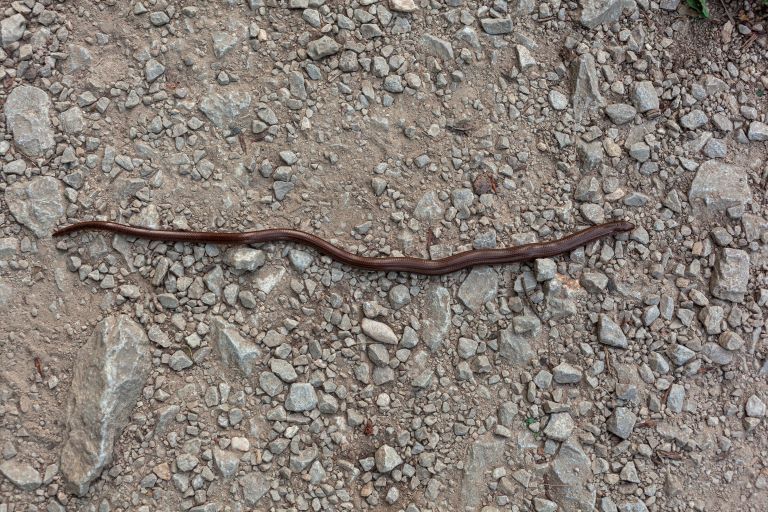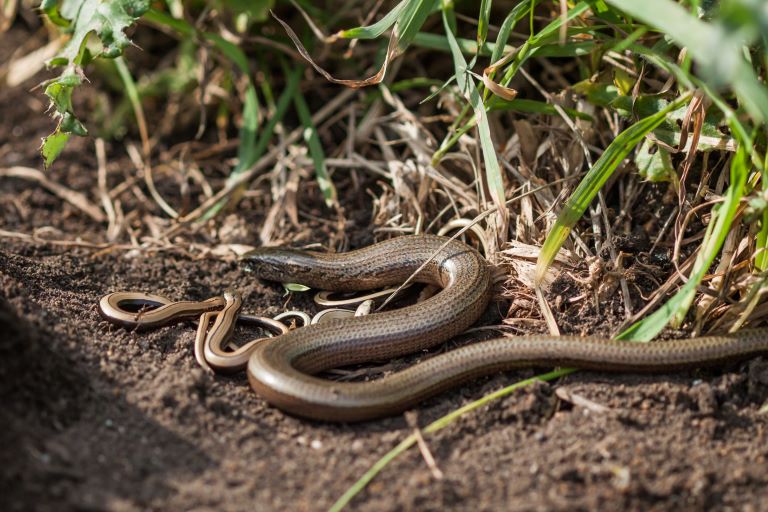Slow Worm Profile
The order Squamata comprises the snakes and lizards, which to be fair, make up most of the reptiles left in the world. The easy way to tell them apart is by their ‘flight or bite’ response. Try shouting “boo!”. If it jumps, it’s a lizard, if it bites you, it’s a snake.
But there are exceptions to this: a Komodo dragon only knows bite and a legless lizard like the slow worm couldn’t jump if it wanted to.
And really, almost all snakes will choose flight before bite, so really this whole thing is better appreciated as a rather forced segue than genuine advice.

Slow Worm Facts Overview
| Habitat: | Grasses, wooded areas, gardens |
| Location: | Widespread across Europe |
| Lifespan: | 54 years |
| Size: | Usually around 10cm – 20cm (3.9 in – 7.8 in) Up to 50cm (20 in) |
| Weight: | Up to 100g (3.52 oz) |
| Colour: | Usually golden brown, striped |
| Diet: | Soft bodied invertebrates like slugs, caterpillars, earthworms |
| Predators: | Birds, snakes, badgers, hedgehogs, foxes and domestic cats |
| Top Speed: | Slow |
| No. of Species: | 5 |
| Conservation Status: | Least Concern (IUCN) |
Slow worms aren’t worms. They’re closer related to snakes, but they aren’t snakes either. They’re actually a line of legless lizards – one of many – that live across Europe, occupying around five species in the genus Anguis.
They’re slow to mate, slow to age, and unfortunately, slow to get out of the way of cars and cats, but at least with the latter they do have a handy decoy to help them escape.
Interesting Slow Worm Facts
1. They’re Anguids
Slow worms are from an unusual and interesting family of lizards known called Anguidae. They represent a small number of around five, very similar, species, all of which are notably legless. This isn’t universal in the family, although other weird characteristics set them all apart.
They have grooved teeth, and bony plating on their bellies. This latter adaptation is useful in the numerous occupants of the genus Anguis, who instead of walking, prefer to use the traditionally snake-like locomotive strategy of wriggling on their bellies.
They enjoy this so much that they have lost their legs entirely, and as such can sometimes be mistaken for their devious biblical relatives, though they evolved this physiology entirely independently (in fact, leglessness in squamates has evolved 25 times, showing just how popular it can be).
As lizards, they also have eyelids, ear holes, and a long tail, which they can use as a decoy when in trouble. And if you look at the skull of a slow worm, you might see extremely fragile rings in the eye socket. These sclerotic rings are not found in snakes but are common in lizards and birds (and fish).
Finally, for those of us who are very hands-on with nature, a slow worm is notably more panicky than a snake. Snakes will generally calm down quickly when caught, but slow worms are entirely inconsolable.

2. They can lose their tails
Snakes can’t do this, either, but the legless lizards are quite good at it. This is the family of lizards that houses the glass-tailed lizard: another legless genus whose ability to explode pieces of themselves off is quite perturbing.
Slow worms aren’t quite as dramatic but will drop a wriggling appendage when in danger, and this is supposed to keep curious cats amused while the rest of the animal escapes intact. Sometimes it works, sometimes it doesn’t, but the tail will partially regrow after a while if it does.
One other thing to note about the tail that differs from a snake’s is that it’s extremely long. You might be thinking that a snake is all tail, but when you peel back the layers, there are distinct ribs and even shoulder and hip joints on the skeleton that give you a clue to where the legs once were.
And the tail of a reptile starts just below the hip joints, around the butt, just like it does in people. In snakes, it’s very truncated, in lizards, the tails are much longer. 1
3. They have legs!
Okay, this is QI levels of provocation, but as mentioned in the snake example, these lizards do have limb joints on the skeleton where their external limbs once sat. They may even have some tiny skin flaps that are the remnants of external legs and are most likely vestigial.
However, they could also come in handy. Pythons and boas, for example, are known for their mating spurs, formed from floating remnants of the femur bone, no longer connected to the spine. This protrusion is present in both males and females, but longer in the males.
A similar usefulness could be found in slow worms, but it doesn’t appear to have been described.

4. They birth live young
Whether they use spurs or not, they can still get the job done. Males will bite the female in the neck, and the two will intertwine in an unsettlingly familiar mating wriggle.
Perhaps less familiar is how long this can go on for. Slow worms live up to their names here and can copulate for up to ten hours. Females often wear the scars of these marathon sessions on their faces, and after a few months, she’ll give birth to roughly 12 live offspring, known as wrigglets. 2

5. They’re extremely long-lived
The slow worm might be the longest-lived lizard in the world.
In captivity, they’ve been recorded living up to 54 years and can pass 30 in the wild. 3
6. Cats and cars are a problem
Being relatively defenseless against both, this is a species that is vulnerable to decline in parts of its range that overlap with these two destructive human forces.
It’s an often-overlooked fact that cats are one of the most destructive invasive species across the world, responsible for killing up to four billion birds and up to 23 billion mammals each year in the US, and hundreds of millions in Europe.
Reptile numbers are harder to come by, but the indiscriminate nature of cats suggests they will be at least proportional to their numbers in the area.
Increased development of roads and housing is also a huge threat to wildlife across the world. The once ubiquitous hedgehog pancakes were a seasonal warning sign in UK towns that was never heeded, and now the species is vulnerable to extinction on the Isles. Slow worms, as reptiles, love to bask on the road surface to warm up and are prone to the same fatalities as a result. They’re also killed by construction work when land is converted for building.
This is a process that is accelerated in such a densely-populated and ecologically-complacent country as the UK but reflects the future of the rest of the continent if conscious efforts aren’t made to address it.
While local populations are in trouble, the species as a whole is currently of Least Concern to the IUCN. 4
Slow Worm Fact-File Summary
Scientific Classification
| Kingdom: | Animalia |
| Phylum: | Chordata |
| Class: | Reptilia |
| Order: | Squamata |
| Family: | Anguidae |
| Genus: | Anguis |
Fact Sources & References
- (2018), “Azza Ventura”, tumblr.
- Lisa Hendry, “Slow worms: Britain’s most unusual lizards”, Natural History Museum.
- RICARDO FERREIRO (2004), “Reproductive ecology of the slow worm (Anguis fragilis) in the northwest Iberian Peninsula”, Sci Hub.
- (2020), “Slow worms ‘killed’ on Bath development site”, itv news.
